Steward of a Legacy
Lynda Waggoner, the director of Fallingwater and vice president of the Western Pennsylvania Conservancy, is recognized around the world as a leading authority on Fallingwater. She also grew up nearby, and her attachment to the house runs deep. Here, she reflects on her long history with Fallingwater — and describes why she’s never lost her sense of wonder in its presence.
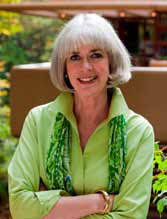
When and how did you first begin working at Fallingwater?
I was in high school. I can’t remember exactly how this happened, but I know that the Conservancy had been operating the house for just about a year and they were surprised at how many people wanted to visit. They needed more guides and were having trouble finding them. I was familiar with Frank Lloyd Wright because we were friends with the Hagans (the family that commissioned Wright’s Kentuck Knob). Either through my mom or through Mrs. Hagan, I got an interview opportunity.
I remember going to the site; at the time, there was just a small gravel parking lot, and we walked on a dirt path through the woods. Coming around the bend, I was just flabbergasted by what I saw. It sounds corny, but it’s true that I had this epiphany that this was going to change my life. I grew up 15 miles away in Farmington, which was very rural — and this was different than anything I’d ever seen before. It spoke to me in a really deep way, and it directed what I did in my studies and ultimately in my career.
Following college, marriage, curatorial positions with other organizations, and the birth of your son, you were hired at Fallingwater by its first director, Tom Schmidt. What were your goals or priorities as a new curator?
As a new part-time curator, my primary focus was to get the collections organized and work out their conservation issues. That first year, we conserved a number of objects in the house that were in trouble, primarily because of the high UV light levels, but moisture damage and poor matting and framing were issues as well. That same year, I worked with photographer Christopher Little to help produce the book Fallingwater, Frank Lloyd Wright’s Country House, which was published in celebration of Fallingwater’s 50th anniversary. He and I also worked together on the 75thanniversary book — and we laughed that we both have grey hair now; we were young when we did the 50th anniversary project! The following year, I was asked to be a full-time curator and site administrator, and my official start date as such was in 1986.
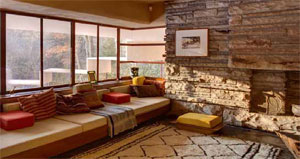
What was Fallingwater like during those early days, and what were your priorities?
We had a fairly small staff here; it was very quiet. Visitation was around 70,000 annually, and it just got bigger and bigger and bigger. Nonetheless, one of the problems we had back in the 80s was too many people on tours. For instance, all of the people scheduled for the 10 a.m. tours would come down to the house at once. At a given time, there could be as many as 75 people in the living room. In the summer, when it was hot, it was unbearable for some people. So we sat down to figure out how we could make this work better — and we began with smaller groups at the pavilion rather than in the living room.
We also worked to even out visitation throughout the year. Initially, during busy months such as August and October, we had as many as 1,300 people going through the house. Now we limit the number of people who can go through the house on any given day to about 900, and visitation is much more even throughout the year.
What is your proudest accomplishment?
When I think back on my career, what I’m most proud of is the restoration of the house. I remember getting the call from John Paul Huguley, a University of Virginia student who was studying under Mario di Val Marana, a member of the Fallingwater Advisory Committee. For his senior project, he undertook a computerized analysis of the structure of the master terrace. Using copies of Wright’s original drawings, this student determined that the master terrace was overstressed and the house was in trouble. That was the first time we’d had any inkling that the building may have structural issues. A lot of people had studied Fallingwater, but no one had ever done computer modeling of how the building worked structurally.
As soon as I got that news, I thought, “This is serious.” I called a friend, who said there was only one person to go to: Robert Silman. Bob is known as a god of preservation engineering, so when I called, I was amazed that I got through to him right away. I introduced myself saying I was from Fallingwater, the house designed by..., and he chuckled, saying, “I know what Fallingwater is.” I described the problem, and he was silent for a minute, and then he said, “It makes sense.”
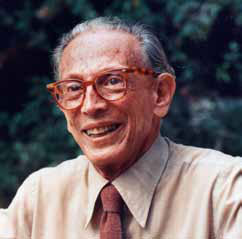
Edgar Kaufmann jr.
So he and his colleagues came and monitored the building for a year with sophisticated computer modeling to confirm that it was in trouble. It was a very anxious time here. At Bob’s recommendation, we blocked off the cantilevered areas on the first floor and second-floor master terrace, until we could get shoring installed to ensure these areas would not collapse. The repair work was exciting but frightening. I’ll never forget watching the steel shoring going in under the living room. It was a terrifying moment — watching huge I-beams swing toward the building above the stream. I could barely look at it.
You came to know Edgar Kaufmann jr., who entrusted Fallingwater to the Western Pennsylvania Conservancy, very well. How would you describe him?
He was terrific. I was intimidated by him initially. Tom Schmidt, Fallingwater’s first director, and I would make trips to New York City to call on him. We’d go to his fabulous apartment on Park Avenue; it was an absolutely beautiful space. And his collection was spectacular; there was a Picasso, a large water lily painting by Monet, two de Koonings, and a Miro — he had an extraordinary eye. Anyway, we’d go there to update him on Fallingwater but also to get information about the house and how it was lived in, and Edgar was wonderful. He was always very generous with his time, and kind.
He had very definite ideas about how Fallingwater should be presented and did not shy away from expressing them. For example, at one point the Conservancy participated in an institutional review of Fallingwater through the American Association of Museums. The reviewer was the deputy director of the Guggenheim at the time, and she criticized a number of things, including the fact that there were no labels identifying the art, and everything was open so people could walk freely around the rooms and potentially damage things. Edgar was appalled by her report. He said that Fallingwater’s art objects were “accoutrements to fine living that could be replaced.” He did not want to compromise visitors’ experiences by having labels or roping off parts of the house.
This approach continues to be a challenge: balancing access to the house and protection of the resource itself. But he was right: Fallingwater is primarily about the architecture and one cannot understand it without the freedom to experience it. So, for a number of years we were criticized for letting people walk in the rooms, but I think it is key to Fallingwater’s great success.
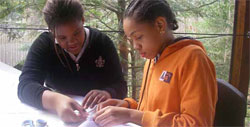
Lincoln Technology Academy students learn about architecture at Fallingwater.
He was also very clear that he did not want the house to be “mummified” as he called it. He believed that too many house museums in the U.S. suffered from that approach; he wanted Fallingwater to remain fresh. He encouraged me to acquire more rugs and textiles and to put fresh flowers throughout the house. Frequently, he would send a chest full of fabrics with the instruction, “Use whatever you’d like.”
Can you share any little known facts about the house — any weird details that only you would know?
My goal throughout my career has been to share everything I know about the house. But there are some little things that are fun. For instance, a key feature of Fallingwater is how the interior stone continues past the glass of the windows to become exterior walls. We call it continuity of surface. The glass is fitted into a chase in the masonry — scribed — so that there is no interruption.
But, in the living room, there is one corner that is not resolved this way because the interior wall is a different material than that of the exterior: inside the wall is concrete and outside it is stone.
When Edgar Kaufmann and I would walk through the house, he would remind me, “Make sure there’s always a pot of rhododendron there, because I don’t want people to see that mistake.”
Do you ever tire of the place? Why or why not?
No. I’ve never gotten tired of it. It’s situated in an extraordinary landscape, and it’s always just so interesting. And there are so many facets to what we do here; it’s a small enough staff that I can be involved in all aspects of managing the house and grounds. Edgar Kaufmann said, “You should aim to keep it that way” — and we have. The other thing that Edgar was intent on teaching us was flexibility: not to become too locked into rules and regulations. We experiment all the time with new ideas, and we survey, measure, reexamine and tweak to see if something will work for us.
What continues to captivate people about Fallingwater?
It is the experience of art in nature. The experience of Fallingwater is a visceral one; it speaks not only to your intellect but also to your emotions. Consequently, it has a much larger audience than either art or nature alone. There are people who are passionate about art but have no interest in taking a walk in the woods, and there are people who love nature but have no interest in art. Fallingwater is accessible to both. But I also think there is a desire deep within all humans that to feel safe and at home in nature — Fallingwater achieves that.
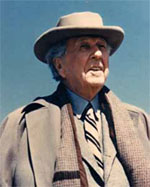
Frank Lloyd Wright
What is your opinion of Frank Lloyd Wright, as someone who knows his work intimately?
My opinion of Wright is that he will be thought of as America’s Michelangelo.
What do you believe is your legacy?
I hope it’s been to protect the building and the collections, first of all. And to provide a visitor experience here that is of the highest quality. That trumps everything else that I’ve wanted to do here.
But there are things I’d still like to do. Our greatest opportunity for the future is to go beyond the public tour and enable people from all over to learn the lessons of Fallingwater. That’s what we hope the on-site educational residency programs will do. No matter how a good tour is, there is nothing better than experiencing Fallingwater without people in it. We can’t do that in any other way except through on-site programming, which allows people to spend time one-on-one with the object itself. Even with the modest programming we have now, some of our former students have gone on to join important architectural offices, and teachers have spoken glowingly about the impact that actually being on-site has had on their teaching.
If we can build additional housing for our educational programming we can have a real impact on the future of architecture and how we look at building. There is nowhere better to understand the relationship between architecture and the natural world than at Fallingwater.
Fallingwater’s
75th Anniversary:
Commemorative Items
from the Fallingwater
Museum Store
View a selection of 75th Anniversary merchandise from the Fallingwater Museum Store.
